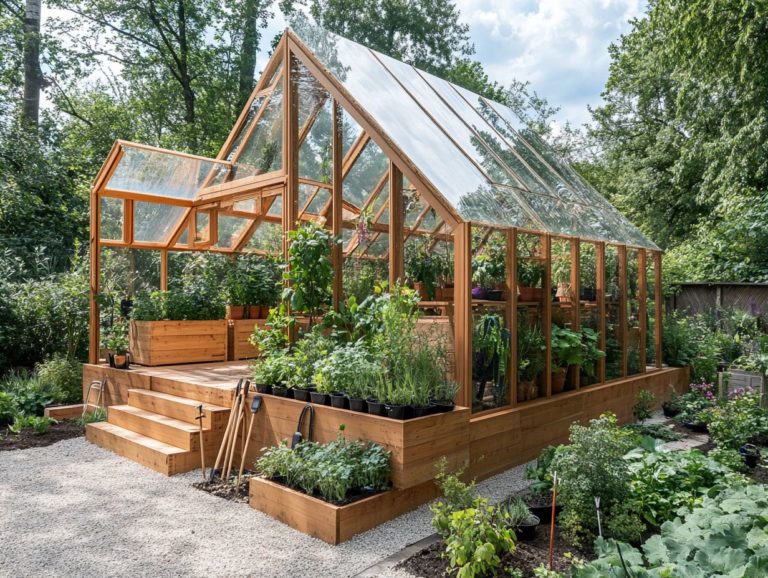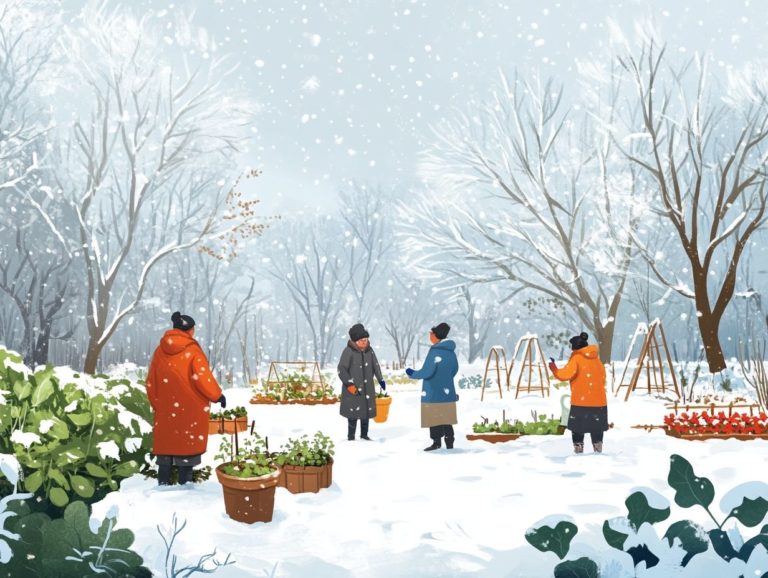How to Extend the Growing Season in Cold Climates?
In cold climates, extending your growing season can fundamentally change how you approach your gardening and farming endeavors.
With the right strategies in place, you can enjoy thriving harvests even as temperatures dip.
This article delves into the importance of prolonging your growing season, examines the various factors that influence it, and presents practical methods such as cold frames, greenhouses, and row covers.
You ll also find guidance on selecting cold-tolerant plants and valuable tips to ensure your extended season is a resounding success.
Seize the chance to maximize your gardening potential and unlock new possibilities!
Contents
- Key Takeaways:
- The Importance of Extending the Growing Season
- Factors Affecting Growing Seasons in Cold Climates
- Methods for Extending the Growing Season
- Choosing the Right Plants for Extended Growing Seasons
- Tips for Successful Extended Growing Seasons
- Frequently Asked Questions
- How to Extend the Growing Season in Cold Climates?
- What is the definition of a ‘cold climate’ in terms of gardening?
- How can I protect my plants from frost in a cold climate?
- What are some cold-tolerant vegetables that can be grown in a cold climate?
- Can I use a greenhouse to extend the growing season in a cold climate?
- How can I start my growing season earlier in a cold climate?
Key Takeaways:
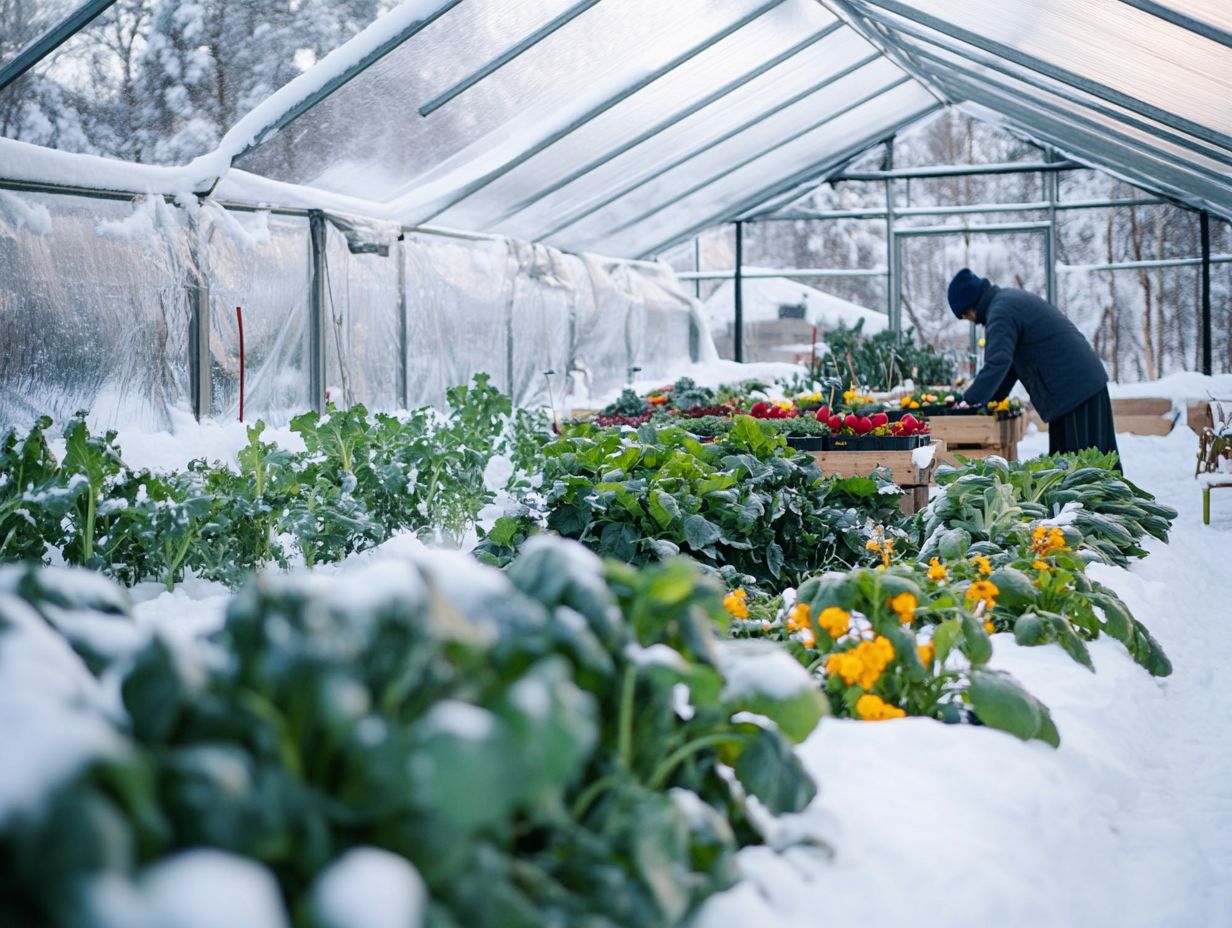
- Extending the growing season in cold climates can provide numerous benefits for both gardeners and farmers.
- Factors such as climate conditions and plant hardiness play a crucial role in determining the length of the growing season.
- Cold frames, greenhouses, and row covers are effective methods for extending the growing season in cold climates.
The Importance of Extending the Growing Season
Extending your gardening season is vital for maximizing yield and ensuring a steady supply of fresh produce, especially in areas where winters can be particularly harsh. For those interested in this, learning how to plan a cold-climate vegetable garden can be incredibly beneficial.
Techniques like cold frames, hoop houses, and row covers can dramatically enhance the viability of your vegetable garden year-round.
Implementing these methods allows you to take full advantage of microclimates (small areas where the climate differs from the surrounding area) and hardiness zones (areas where certain plants can thrive based on temperature), leading to more successful organic gardening practices.
Experts such as Rick Stone of Our Stoney Acres in Utah have championed these strategies, proving their effectiveness in providing winter harvests and maintaining soil health throughout the seasons.
Benefits for Gardeners and Farmers
The advantages of extending your growing season are remarkable, offering you the chance to cultivate a rich variety of fresh produce while maintaining optimal soil health. To learn more about the timing, check out this guide on when to start planting in cold climates.
This additional time in the garden opens the door to introducing different vegetable varieties, ensuring a steady supply of nutrients and boosting your overall yield.
By incorporating late-season crops, you can fill in the gaps in your harvest calendar, maximizing both production and profitability.
Utilizing effective gardening techniques like crop rotation not only prevents soil depletion but also enhances healthy microbial activity, keeping your soil fertile and thriving.
Embracing these methods unlocks new possibilities for sustainable agriculture, benefiting not just you as the grower but also the entire ecosystem.
Factors Affecting Growing Seasons in Cold Climates
Understanding the factors that influence growing seasons in cold climates is vital for any gardener who wants to maximize their harvest using the best cold-weather gardening techniques.
Temperature fluctuations, soil conditions, and specific hardiness zones significantly determine which plants can thrive in your garden.
Embracing microclimates opens unique opportunities for extending your growing season.
Selecting cold-hardy vegetables like kale, carrots, and spinach is essential for successful gardening during the colder months, enabling you to enjoy a winter harvest that keeps your table filled with fresh produce even in the off-season.
Climate Conditions and Plant Hardiness
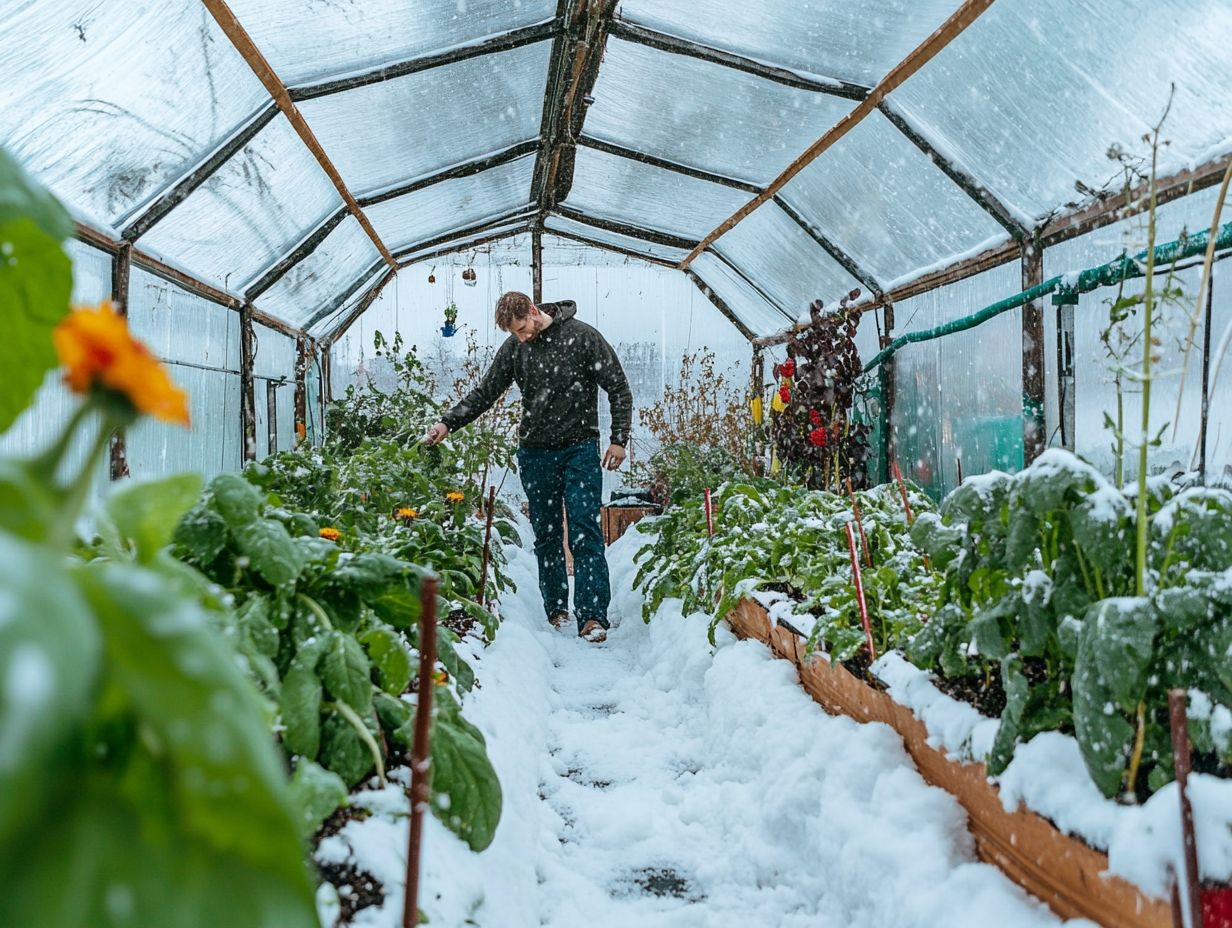
Climate conditions play a pivotal role in determining plant hardiness, influencing which species can truly thrive in specific environments.
Knowing your hardiness zone is crucial for gardeners and landscapers, as these zones offer a valuable framework for evaluating which plants are best suited to your local climate.
These zones are established based on a range of factors, including average annual minimum temperatures, humidity levels, and precipitation patterns. This knowledge gives you the power to make informed choices about your plant selections.
When choosing plants, it’s crucial to consider not just the hardiness zone but also the microclimates in your area.
Factors like soil types and elevation can significantly impact growth potential.
By thoughtfully aligning your plant choices with their ideal climate conditions, you can cultivate a thriving garden ecosystem that flourishes beautifully throughout the seasons.
Methods for Extending the Growing Season
You have a wealth of effective methods at your disposal for extending the growing season and maximizing your yields. Consider employing cold frames, greenhouses, or hoop houses. Additionally, learning how to start seeds indoors for cold climates can provide frost protection and foster ideal microclimates for your plants to thrive.
Row covers and cloches are excellent for shielding delicate plants from chilly temperatures while still allowing precious light to penetrate. Don t overlook the power of mulching, which helps retain soil warmth and creates a nurturing environment.
Each of these techniques plays a unique role in your gardening arsenal, providing distinct advantages for maintaining a vibrant and healthy vegetable garden.
Cold Frames and Greenhouses
Cold frames and greenhouses are essential tools for you as a gardener. They allow you to extend your growing season and cultivate a diverse array of vegetables year-round.
Imagine having complete control over your plant s environment! These structures create a controlled environment that enhances temperature regulation and shields your plants from harsh weather conditions.
By trapping sunlight, cold frames ensure a warmer climate during the colder months. Greenhouses offer a more permanent solution for consistent growth throughout the year.
Start enjoying these benefits today! You can achieve reduced vulnerability to pests and diseases, along with the ability to start seeds earlier in the season. Leafy greens, root vegetables, and resilient herbs flourish in these environments, making them perfect for winter gardening enthusiasts like you who wish to savor fresh produce, even amid the season s chill.
Row Covers and Mulching
Row covers and mulching are critical gardening techniques that not only provide frost protection but also enhance soil health throughout the growing season.
These methods shield your delicate plants from unpredictable weather changes whether it s an unexpected frost or a heatwave. They also help with moisture retention and suppressing weeds.
By creating a microclimate under row covers, you can extend your growing season, allowing for earlier plantings and later harvests.
Applying mulch helps roots grow healthier by regulating soil temperatures and promoting beneficial microbial activity. When you employ these techniques effectively, you can see significant improvements in both crop yield and quality, especially when customized for your specific climate.
For example, in cooler regions, lightweight fabrics can warm the soil more quickly. In warmer areas, organic mulches break down to enrich the soil.
Choosing the Right Plants for Extended Growing Seasons

Selecting the right plants is essential for achieving successful extended growing seasons. For example, understanding how to grow potatoes in cold climates can help you focus on hardy varieties and cold-tolerant options.
Consider incorporating vegetables like Swiss chard, beets, and kale into your late-season planting. They re outstanding choices that offer substantial yields and fresh produce even during the chillier months.
By employing specific planting tips and gaining insight into the characteristics of various vegetable varieties, you can optimize your garden for season extension. This ensures a vibrant yield that spans the entire year.
Hardy Varieties and Cold-Tolerant Plants
Hardy varieties and cold-tolerant plants are vital to creating a successful extended gardening strategy, especially when you learn how to grow beets in cold climates.
These resilient plants think kale, spinach, and certain root vegetables like carrots and turnips allow you to enjoy fresh produce even as temperatures dip. They thrive in cooler conditions, making them perfect for winter gardening.
For example, the popular Winterbor kale can withstand frost. Florida Broadleaf spinach is celebrated for its impressive growth in low light. Not only do these plants offer nutritional benefits, but they also boost your garden’s productivity during the colder months, enabling you to harvest fresh greens well after traditional crops have wrapped up their seasons.
Tips for Successful Extended Growing Seasons
Successful extended growing seasons hinge on a combination of good timing and care. By mastering these elements, you can ensure your plants thrive in various conditions and unlock their full potential.
Proper Timing and Maintenance Techniques
Proper timing and maintenance techniques are essential for achieving successful extended growing seasons in your garden.
Understanding the planting and harvesting cycle is crucial. It can elevate your yield and improve your plants’ health.
For example, seedlings need a process called getting used to the outdoor environment before they re ready to brave the outdoors. This means gradually exposing them to outdoor conditions, allowing them to acclimate seamlessly to their new environment.
Timing your planting just before the last frost gives your crops a valuable head start. By incorporating practical tips like enriching the soil, keeping an eye on weather patterns, and staying attuned to local climate changes, you can ensure your crops flourish.
Regular maintenance is essential for success.
Consistent watering and vigilant pest control can lead to a truly bountiful harvest.
Frequently Asked Questions
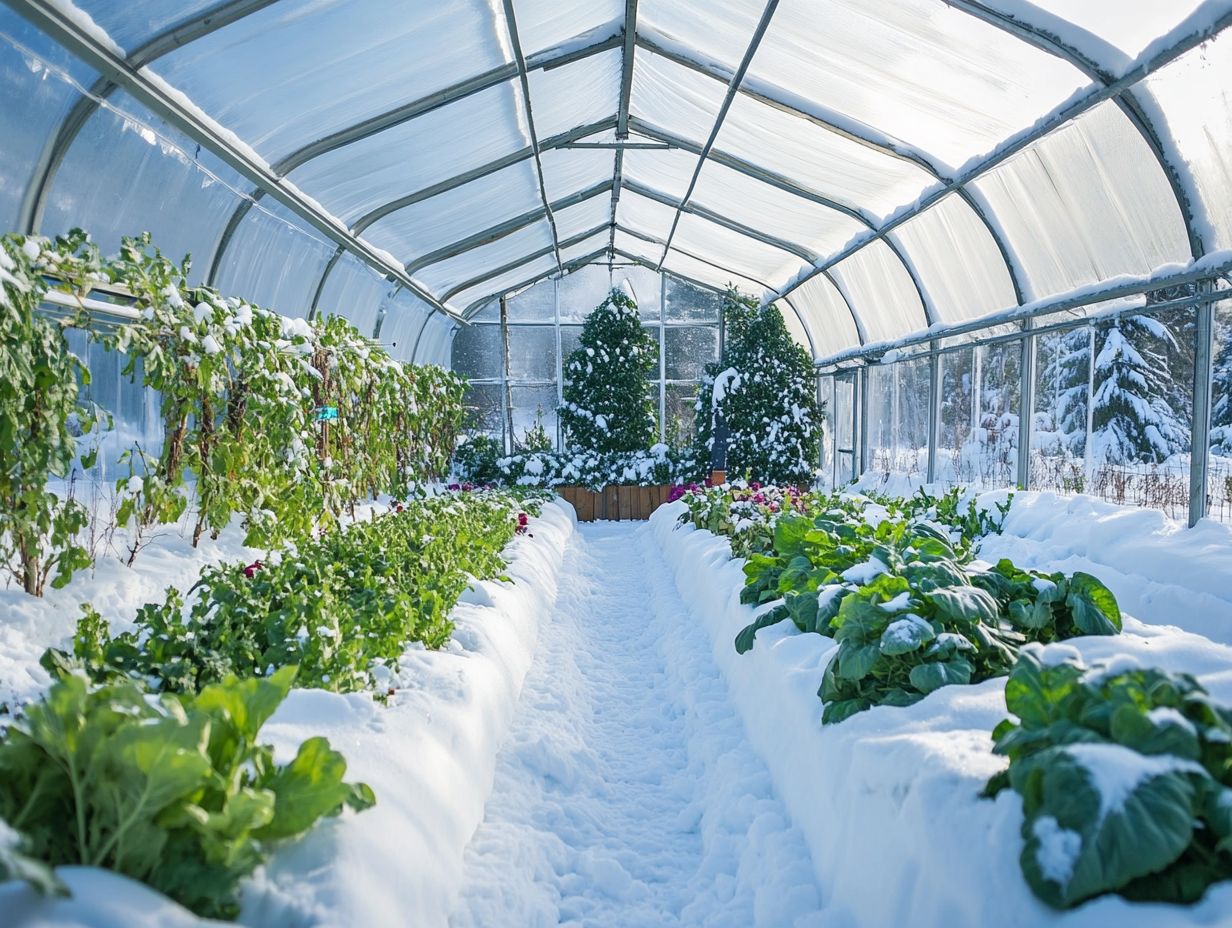
How to Extend the Growing Season in Cold Climates?
The growing season in cold climates can be extended by following these tips:
What is the definition of a ‘cold climate’ in terms of gardening?
A cold climate is typically defined as an area that experiences frost or freezing temperatures for a significant portion of the year. These conditions make it difficult to grow plants.
How can I protect my plants from frost in a cold climate?
To protect your plants from frost, you can use methods such as covering them with a frost cloth or creating a mini greenhouse with plastic sheeting. You can also use mulch to insulate the soil.
What are some cold-tolerant vegetables that can be grown in a cold climate?
Some cold-tolerant vegetables include broccoli, cauliflower, carrots, spinach, kale, and Swiss chard. These hardy plants thrive even in frost! Grow them to ensure a steady supply of fresh veggies all season long!
Implementing crop rotation changing the plants you grow in a specific area each year to keep the soil healthy and selecting hardy plants will also benefit your vegetable gardens.
Can I use a greenhouse to extend the growing season in a cold climate?
Yes, a greenhouse can be a great way to extend the growing season in a cold climate. Using high tunnels or greenhouses offers a controlled environment where plants can thrive even in colder temperatures. For those interested in getting started, check out this guide on how to start a cold-climate garden. These methods are ideal for winter gardening.
How can I start my growing season earlier in a cold climate?
You can start your growing season earlier by using techniques such as seed starting indoors or using raised beds to warm the soil faster. Additionally, learning how to grow berries in cold climates can help you make the most of your gardening efforts, while using cold frames to protect young plants from frost is another effective method.
This will help you achieve a successful winter harvest.
Ready to boost your garden s potential? Start implementing these tips today!





